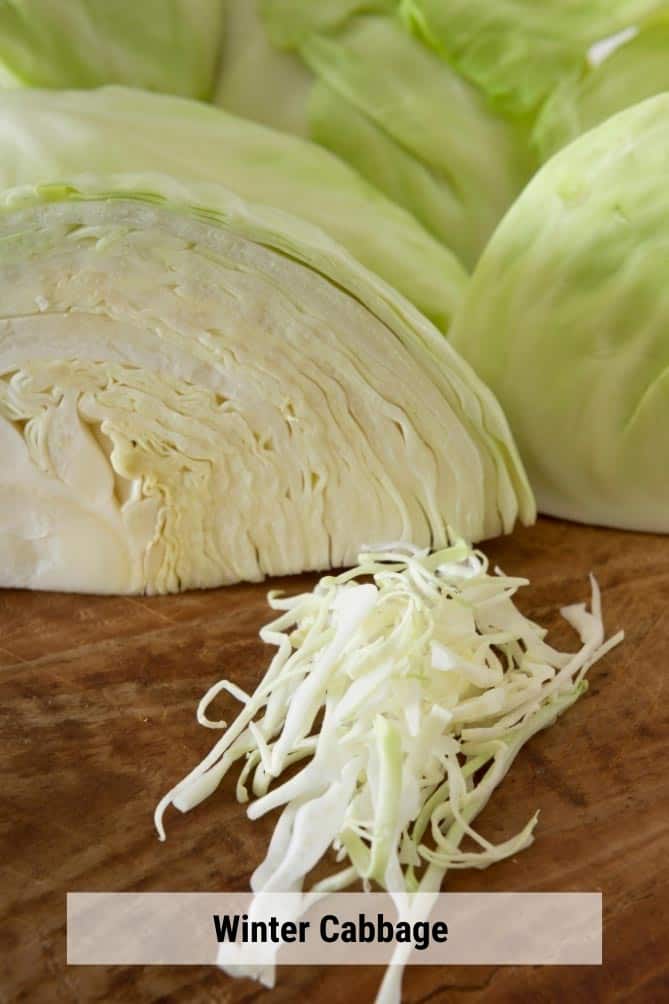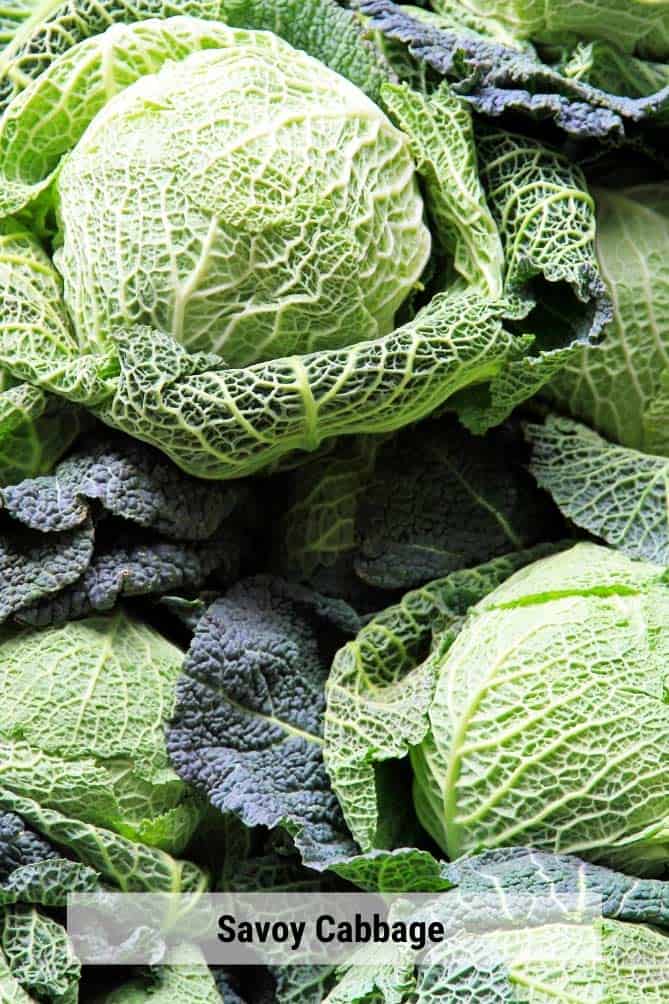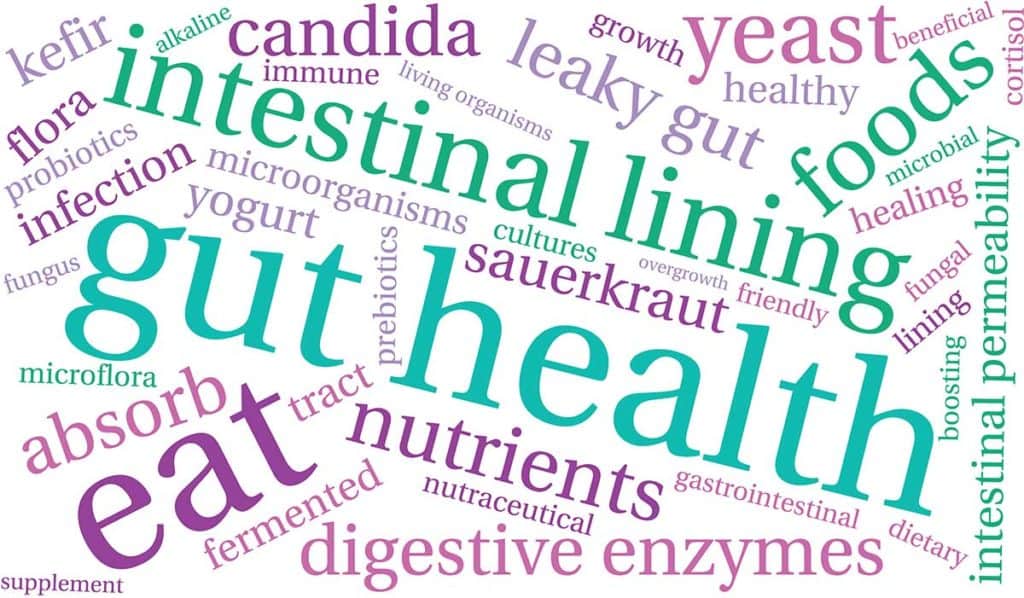Discover the best-kept secret of sauerkraut making: the right type of cabbage. Learn which type will give you perfect fermentation with plenty of brine and tangy flavor. Never settle for bland sauerkraut again.

Today I’m going to share with you what cabbage is best for sauerkraut.
I’ve been making naturally fermented sauerkraut for over twenty years and have tried many types but only one consistently produces sauerkraut with the right texture and plenty of brine.
I’ll share which type gives you the best results and also the time of year that the ideal cabbage is grown.
Let’s get started!
Best Cabbage Type for Fermentation
Most cabbage varieties can be fermented. But the common, green, round-headed cabbages are most often used to make sauerkraut and will give you the best results.
I use the term “type” as a general classification for the various “varieties” of sauerkraut.
The more common types of cabbage are green, red, savoy, and Napa (or Chinese).
Green Cabbage: The Best Cabbage for Sauerkraut

Green cabbage, which is sometimes called white cabbage, is my favorite when it comes to making sauerkraut. It has wide fan-like leaves that are pale green in color.
I almost always use the traditional round-headed green cabbage, because it is commonly grown by my local farmers, has a nice texture, and retains most of its crunch throughout the fermentation process.
If you are starting with your first batch of sauerkraut, I recommend that you start with green cabbage. It ferments fabulously, which is one more way to guarantee success, and it gives you a baseline to gauge how future batches are fermenting.
Summer vs. Winter Cabbage
Knowing the difference between summer and winter cabbage can be a game changer for fermentation success.
Green cabbage is harvested in both summer and winter.
The variety of green cabbage that is harvested in summer is best for coleslaw or fresh eating. The variety of cabbage harvested in fall and early winter is best for sauerkraut.
Summer Cabbage

Summer cabbage has lower moisture content. It is sown in early spring and harvested throughout the summer. It grows faster than winter cabbage and has thinner leaves.
When you cut open summer cabbage, you’ll notice that the leaves are loose with hollow spaces between them.
Summer cabbage is used in coleslaw and cabbage rolls.
Winter Cabbage

Winter cabbage, on the other hand, is sown in late summer and harvested in late fall (usually, after a few nights of frost).
It has a higher moisture content which is ideal for sauerkraut. It grows slower than summer cabbage and has thicker leaves. Cabbage also reacts to cold conditions and frost by producing sugars, making it taste rather sweet.
Since the bacteria responsible for fermentation need sugar to create lactic acid, cabbage that has a high amount of natural sugar will ferment well, and result in tasty and tangy sauerkraut.
When you cut open winter cabbage, you’ll notice that the leaves are compact and tight with little or no hollow space between them. In addition, winter cabbage will feel quite heavy for its size, often 1 – 2 times heavier than summer cabbage of the same size.
Though cabbage is available all year round, it is best to use winter cabbage that first appears on store shelves and in markets in late fall.
When you first start learning to ferment, you most likely will just grab whatever cabbage is available and whatever time of year you are fermenting. As time goes on, however, work to “level up” your fermentation skills and start gravitation towards fermenting in the late fall with freshly-harvested winter cabbage.
Winter Cabbage Varieties
If you are a gardener, some of the best varieties of cabbage for making sauerkraut are:
- Krautman
- Brunswick
- Golden Acre
- Glory of Enkhuizen
- Danish Ballhead
- Late Flat Head
- Premium Late Dutch
- Quintal d’Alsace Cabbage
These varieties of cabbage grow from early summer to fall and mature around the time of the first fall frost.
Red Cabbage: High in Vitamin C

Red cabbage has a maroon or purple color, thus, some call it purple cabbage. It has an earthier and stronger flavor compared to green cabbage.
Its dark color suggests that it is a healthier option. Red cabbage contains more nutrients, like Vitamin C, Vitamin A, and iron than green cabbage.
In fact, red cabbage has one of the highest levels of naturally available vitamin C, which is 30% more than that of green cabbage, and even more than the vitamin C content of oranges! One reason why many like to use red cabbage for fermentation.
A compound called anthocyanins gives red cabbage—as well as blueberries, Concord grapes, and black tomatoes—its distinctive dark color.
Anthocyanins act as antioxidants and are believed to have anti-inflammatory properties. Researchers from Cornell University found that raw and fermented red cabbage has the highest antioxidant capacity compared to other cabbage varieties.
Ready to reap the impressive benefits of red or purple cabbage? Try this red cabbage sauerkraut recipe!
Savoy Cabbage: Thin Leaves Ferment Too Quickly

Savoy cabbage is similar to green cabbage, but its leaves are of a darker green color, ruffled, tender, and less densely packed together.
It ferments more quickly than common green cabbage and you’ll end up with softer sauerkraut. I rarely, if ever, use savoy cabbage for fermentation.
If you do use savoy, monitor texture and ferment for a shorter time period.
Napa Cabbage [Chinese Cabbage]: Great for Kimchi

Another type of cabbage that is more commonly used for Kimchi and other Asian cuisine is Napa cabbage, also called Chinese cabbage.
It is oblong-shaped with white stalks and crinkly, light yellow to pale green leaves. Compared to the first three types of cabbage, Napa cabbage is softer and has a milder flavor.
These are only four out of the many cabbage varieties that you can ferment. No matter what type of cabbage you use, sauerkraut is best made with fresh cabbage or newly harvested ones.
Selecting cabbage

Whether you buy your cabbage from the market, from a local farmer, or grow your own cabbage, selecting good quality produce will do wonders for your sauerkraut’s flavor and texture.
Here’s what to look for when selecting a head of cabbage.
Firm and compact
Choose cabbage heads that are firm, compact, and dense, or heavy for their size. These are signs that the cabbage is fresh. A soft and spongy cabbage may be rotten inside.
Sweet flavor and odor
If possible, taste a few slices of the raw cabbage. Choose the cabbage that is sweet to taste and stay away from bitter cabbage.
The stronger the odor and flavor, the older the cabbage. The sugars in sweet-tasting cabbage aid the fermentation process and result in a greater depth of flavor in your sauerkraut.
Bright, shiny, and crisp leaves
Another way to evaluate the freshness of cabbage is through its leaves. Choose cabbage heads with bright-colored, shiny, and crisp leaves. Make sure that they are not wilted, brown or blemished.
Some cabbage sellers may take out the wilted outer leaves. It’s best to avoid those. In that case, you can check if the leaves are compact and not beginning to separate from the stem.
Fresh and newly-harvested
We are fortunate that cabbage stores well and you can successfully ferment with it throughout the year. However, if you are getting less than stellar results with your sauerkraut, I find that the use of old cabbage that has been stored for many months is often the culprit.
When cabbage is picked and stored for a while, it dries out and loses moisture. Sauerkraut made using this kind of cabbage has less brine. Fresh cabbage will be teeming with beneficial bacteria and will enable you to have a successful ferment.
Whole cabbage instead of precut or shredded
It is not advisable to buy precut cabbage because it begins to lose its vitamin C content from the moment it is cut. Shredded cabbage or cabbage in bags is also more expensive.
In addition, some of the bagged cabbages are treated with preservatives that could interfere with fermentation.
Organic
It is always best to use organic produce for sauerkraut because the nutrients in cabbage and other vegetables are retained. Cabbage loses its nutrients when sprayed with pesticides.
But depending on where you are, organic cabbage may not be easily accessible or affordable. In that case, it might be comforting to know that cabbage is part of the Environmental Working Group’s “Clean 15”, which is a list of fruits and vegetables with the lowest concentrations of pesticides.
Also, pesticide residues and other toxins may be broken down and degraded during fermentation as shown in the 2008 study by the Iranian Agricultural Engineering Research Institute and a 2009 study by the Gyeongsang National University in Korea.
This is why, technically, sauerkraut is safer to eat than coleslaw or fresh green salad. This is not to say that you should stop eating salads but instead don’t be fearful of eating something left to ferment on your counter for days, if not weeks.
In addition to pesticide residues being degraded during fermentation, pathogenic bacteria are killed off by the bacteria responsible for fermentation.
Cabbage Buying Guide
Below is a summary of what type of cabbage to buy and what not to buy to have top-quality cabbage for your sauerkraut.
How much cabbage to buy?
If you’re making one quart (liter) of sauerkraut in a jar (a good-sized batch for your first recipe), look for a head that weighs 2-2½ pounds (1 kilo).
A one-quart (one-liter) batch of sauerkraut uses 1¾ pounds (800 grams) of ingredients.
If you add other ingredients (shredded carrots or beets, onion, etc.), for variety and flavor, you won’t use as much cabbage.
| Look For: | Avoid: | |
| Cabbage Head | Firm, dense, and heavy for its size. Whole head of cabbage. | Soft and spongy. Precut or shredded cabbage. |
| Leaves | Compact leaves; bright, shiny, and crispy | Leaves are separated from the head; wilted, blemished, or brown. |
| Flavor and Odor | Sweet flavor and odor. | Bitter or strong flavor and odor. |
| Freshness | Fresh and newly harvested. | Stored for months. |
| How cabbage was grown | Organic. | Sprayed with pesticides. |
Remember that the better the quality of your ingredients for your sauerkraut, the healthier and more flavorful it will be. The nutrients in the vegetables are the food of the good bacteria that help in the fermentation process. Feed them well.
How to Store Cabbage
If you have purchased cabbage that you’re not able to use right away, here are some suggestions for storing it. You also might be fortunate enough to grow your own and are looking for storage ideas before it can all be processed into sauerkraut.
On the counter, a cabbage head can only last for a few days. Store cabbage in a cool and damp place to prolong its life. Some nutrients in cabbage are susceptible to heat. Thus, avoid storing cabbage under direct sunlight.
What is the best way to keep cabbage fresh?
Refrigerator storage. When storing cabbage in the fridge, remove brown or damaged leaves. Wrapping the cabbage tightly in plastic and storing it in the crisper will make it last longer for up to about 2 weeks.
You might notice a slight odor on the cabbage after some time, but it is still good to use. Wrapping the cabbage in a damp paper towel first before putting it in plastic will also help retain its moisture.
When cabbage is cut open, it can only last for about 2-3 days. To extend its life, you can store halves of cut cabbage in a sealed plastic bag or container and then refrigerate.
Root cellar. Store cabbage in a cool and dark area. For those who have a root cellar, wrap the cabbage heads individually in paper and store them separately.
Fermenting. Fermenting cabbage into sauerkraut is a great way to preserve cabbage for longer periods of time, and to get a lot of nutritional benefits. All you need is fresh cabbage and salt!
Nutritional Benefits of Cabbage
Cabbage is a cruciferous vegetable belonging to the mustard family, Brassicaceae. You’ll also find kohlrabi, kale, broccoli, brussels sprouts, and cauliflower in this family. There are many advantages to including this superfood in your diet.
Reduce the risk of cancer. Cabbage is a nutrition powerhouse. Studies support that cruciferous vegetables reduce the risk of cancer due to the presence of sulforaphane, a compound that causes their strong and bitter taste. Sulforaphane supports the body’s production of detoxification enzymes.
Vitamins and minerals. Aside from its anti-cancer properties, cabbage is also packed with vitamins and minerals like Vitamin C, K, B6, Folate, and Manganese. Vitamin C in cabbage helps reduce inflammation, boosts immunity, and promotes skin elasticity, and overall health.
Antioxidants protect our cells from free radicals, which are linked to diseases like cancer and Alzheimer’s. Moreover, the fiber and water content of cabbage helps in digestion and the removal of toxins from the body.
Gut health. Cabbage is also a rich stimulant for digestive enzymes and will stimulate a healthy balance of stomach acid.
Added Benefits of Fermented Cabbage (Sauerkraut)

When fermented, cabbage has even more health and nutritional benefits compared to raw or cooked cabbage.
Sauerkraut contains natural probiotics or good live bacteria that help remove the extra bad bacteria in the body, and thus, maintain a healthy balance of microbes. This promotes good digestion, strengthens the immune system, and controls inflammation.
A study showed that fermentation even increased the antioxidant properties (vitamin c levels) of red cabbages.
Acetylcholine, an organic chemical found in sauerkraut, aids in digestion and bowel movement. The lactic acid produced in cabbage fermentation increases lactic acid which inhibits bad bacteria.
Sauerkraut is one of the superfoods with the highest vitamin C content. Red cabbage sauerkraut has about 700 mg of vitamin C, which is ten times the recommended amount for daily intake.
These are only a few of the reasons why you should eat a forkful of sauerkraut daily.
How to Ferment Cabbage
There you have it. Now, you know what to look for when selecting cabbage for fermentation. Grab a head and start fermenting.
The best place to start?
How to Make Sauerkraut in a Jar: The Complete Guide is not “just a recipe,” but instead a mini fermentation course in which I teach you everything you need to know to successfully ferment sauerkraut using a jar and other items found in your kitchen.
My proven tips, step-by-step photos, and helpful notes have you covered. Dependably delicious!
Here are some other tips to get you started with success.
- Select the best salt for sauerkraut. Salt is used to create the brine in which the cabbage mixture ferments.
- Use the right amount of salt. The best fermentation results are achieved with a 2% salt concentration.
- Weigh your ingredients. When I started using a digital scale for making sauerkraut, nasty-smelling, moldy sauerkraut became a thing of the past.
- Ferment within the ideal temperature range. Learn this range and why the various stages of fermentation best unfold at proper temperatures.
- Grab some fermentation tools. I share what tools I recommend and what are some of my favorites.
Once you’ve learned my proven method, try this simple sauerkraut recipe. Or, select from one of these many recipes.
When scanning through sauerkraut recipes, you will quickly see that you can add other ingredients to your cabbage to make sauerkraut.
Best Way to Cut Cabbage for Sauerkraut
Cabbage into Sauerkraut: Frequently Asked Questions
Traditional round-headed green cabbage, which is sometimes called white cabbage, is my favorite when it comes to making sauerkraut and is what is commonly found at the grocery store. It has wide fan-like leaves that are pale green in color.
In addition, green cabbage is usually grown by my local farmers, has a nice texture, and retains most of its crunch throughout the fermentation process.
You don’t need to wash or rinse the cabbage. Just remove any outer leaves that are browned or damaged. As you slice your cabbage, keep an eye out for any dark bits and remove those as you go.
Any cabbage will work for sauerkraut, but I find I get the best results with regular green cabbage.
Yes, the colors of the red cabbage will give your sauerkraut a beautiful pink color.
The older the cabbage, the fewer beneficial bacteria it contains for good fermentation results. However, it’s hard to know how old the cabbage that you buy at the store is.
For best results use a heavy head with bright shiny leaves. Don’t use a yellowed head with dull browning leaves.
A knife, a mandoline, and even a food processor can be used to slice cabbage. Each has its pros and cons and impacts the final texture of your finished ferment.
See How to Slice Cabbage for Sauerkraut for more details.
Now, go grab that perfect head of cabbage and make yourself a batch of tangy, probiotic-rich sauerkraut with plenty of brine and just the right texture.
Let us know in the COMMENTS what type of cabbage you use.



 This post may contain affiliate links which won’t change your price but will share some commission.
This post may contain affiliate links which won’t change your price but will share some commission.




